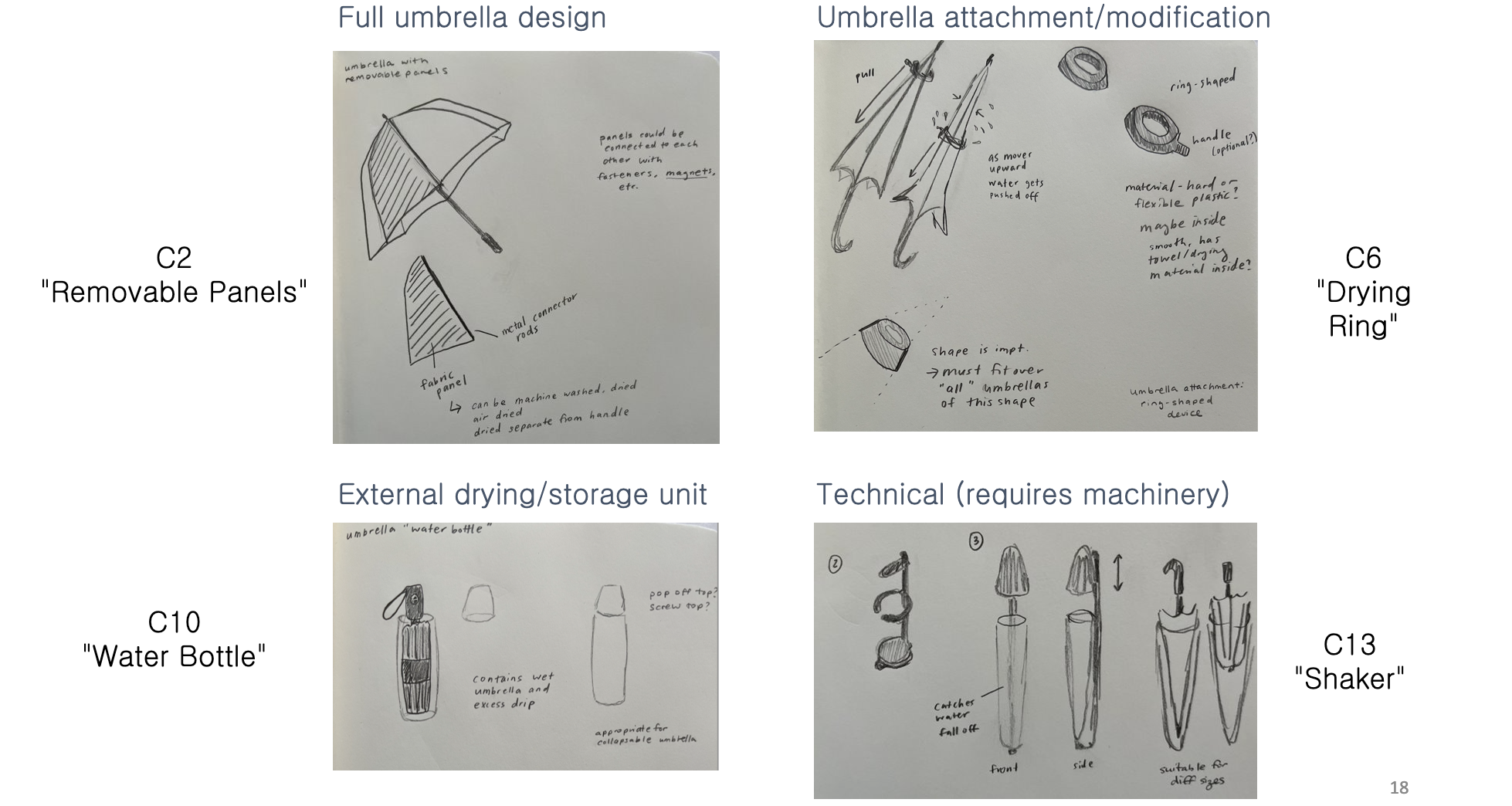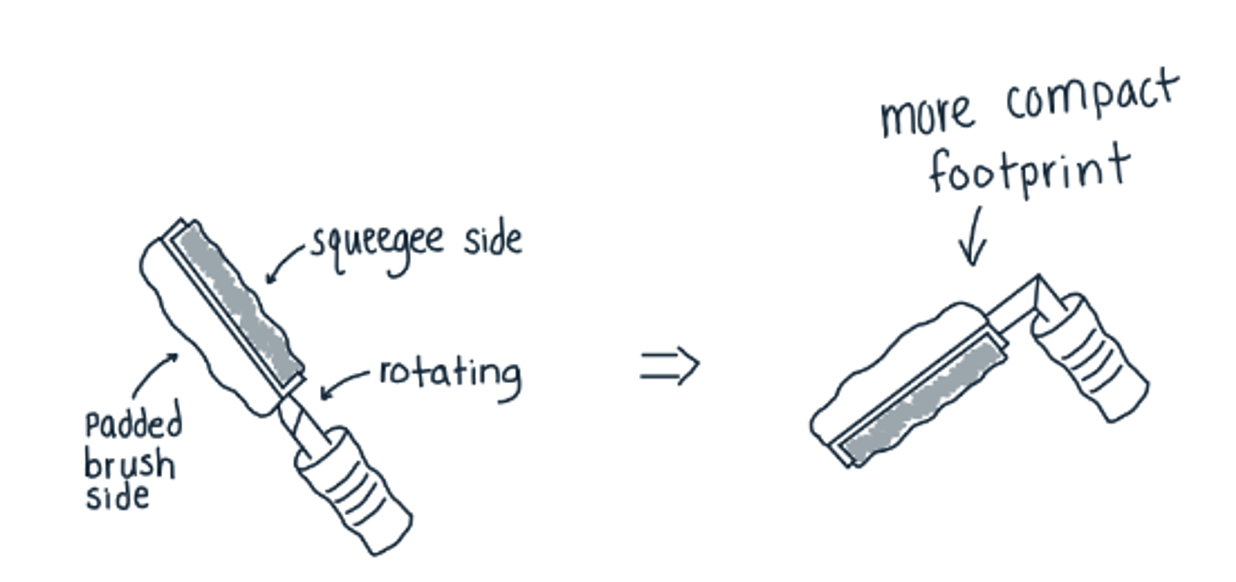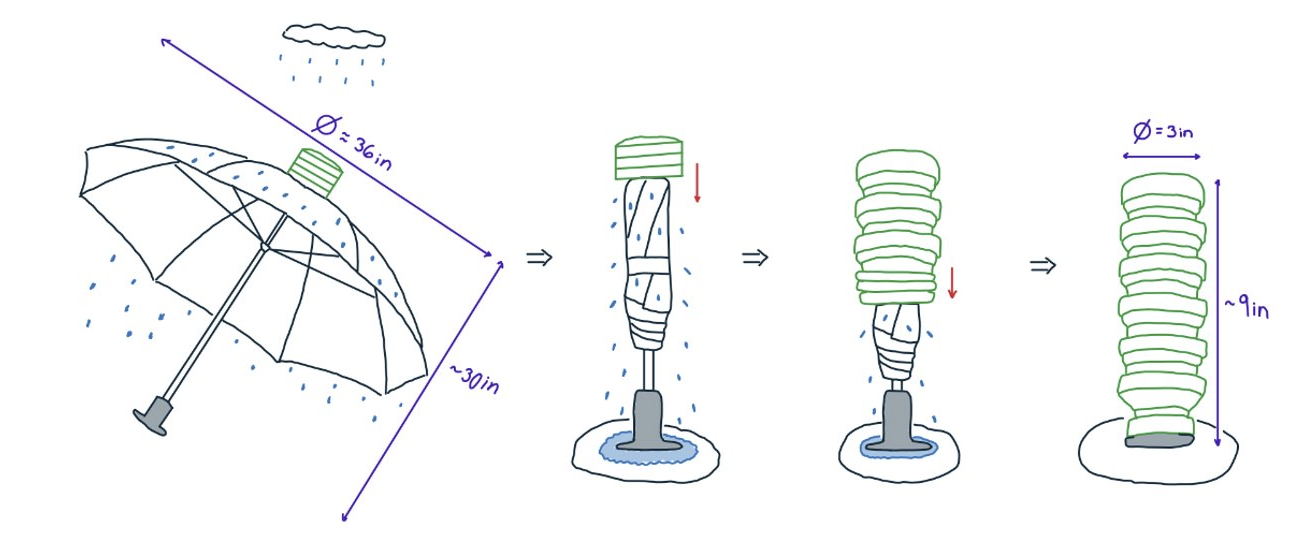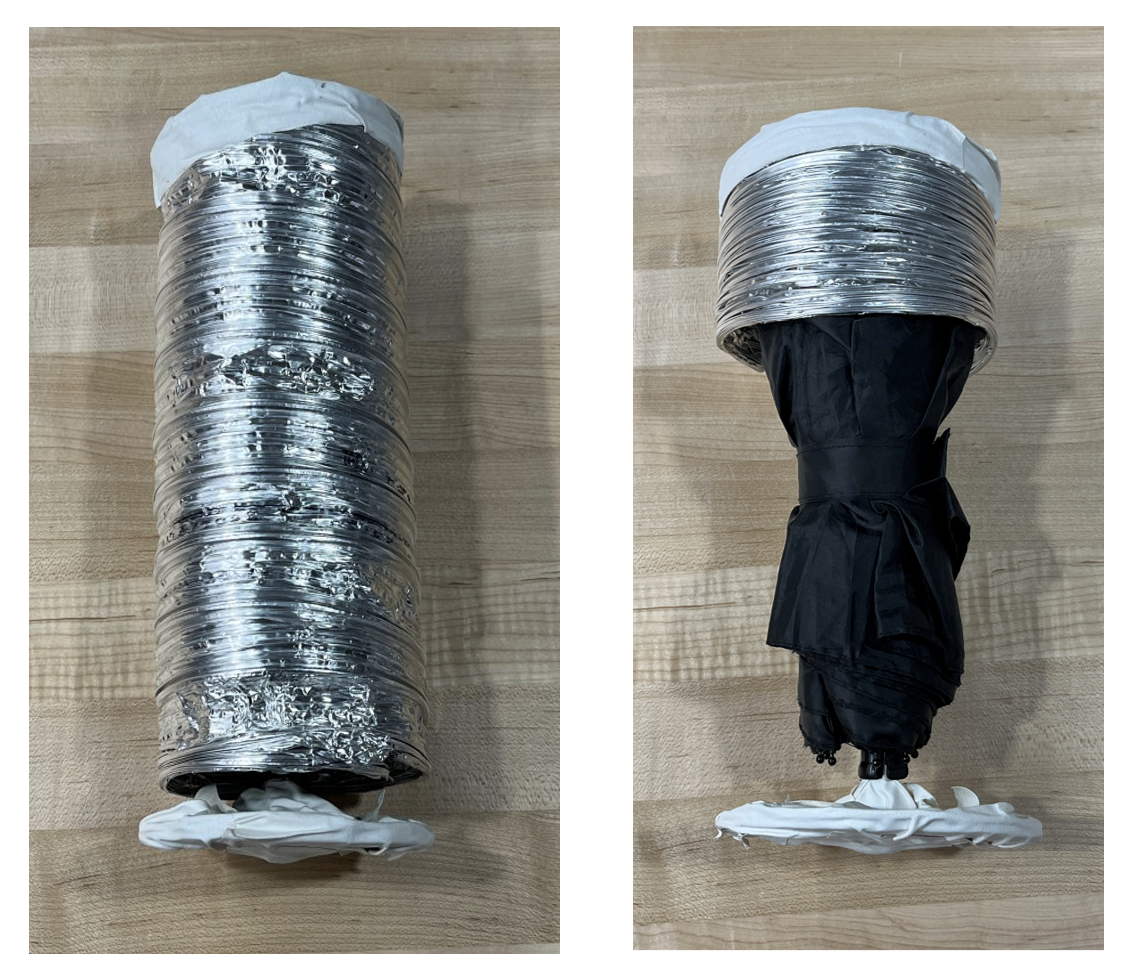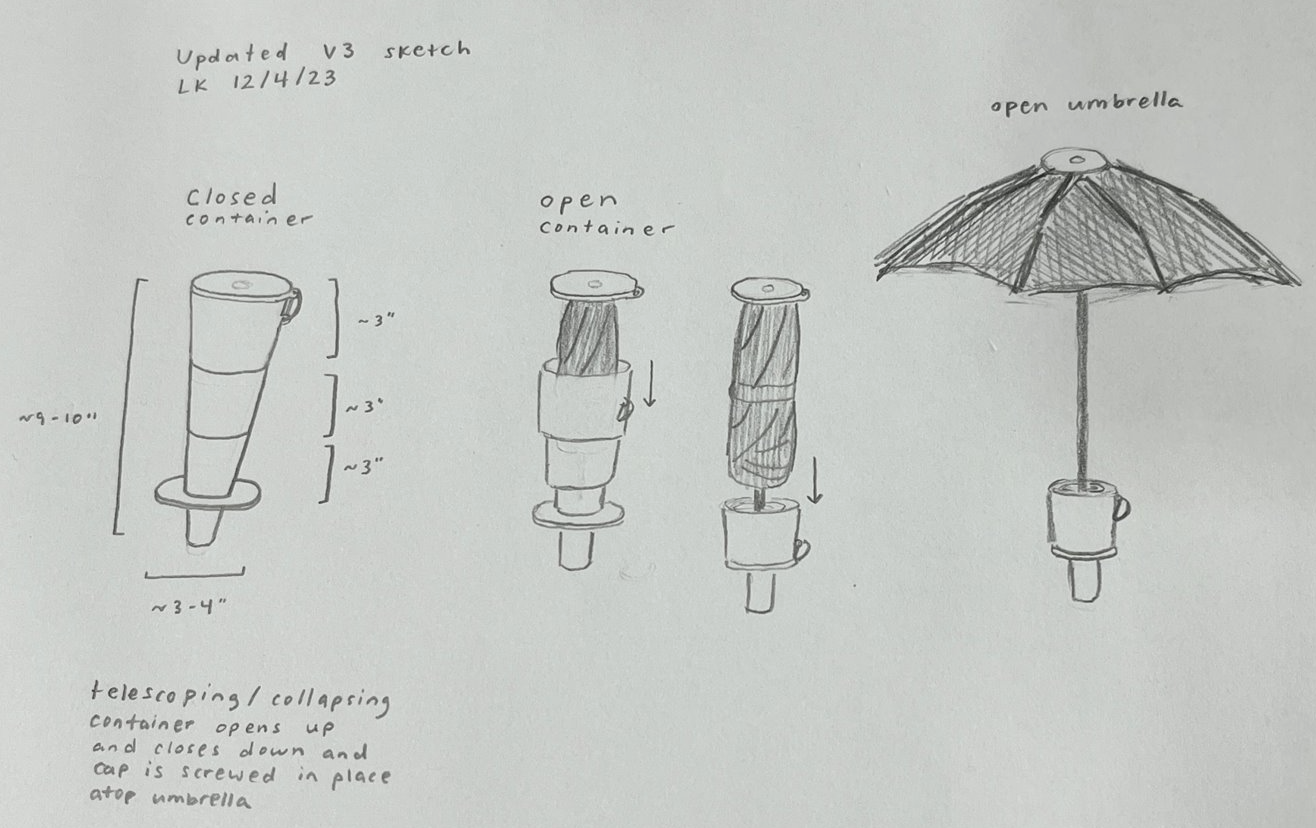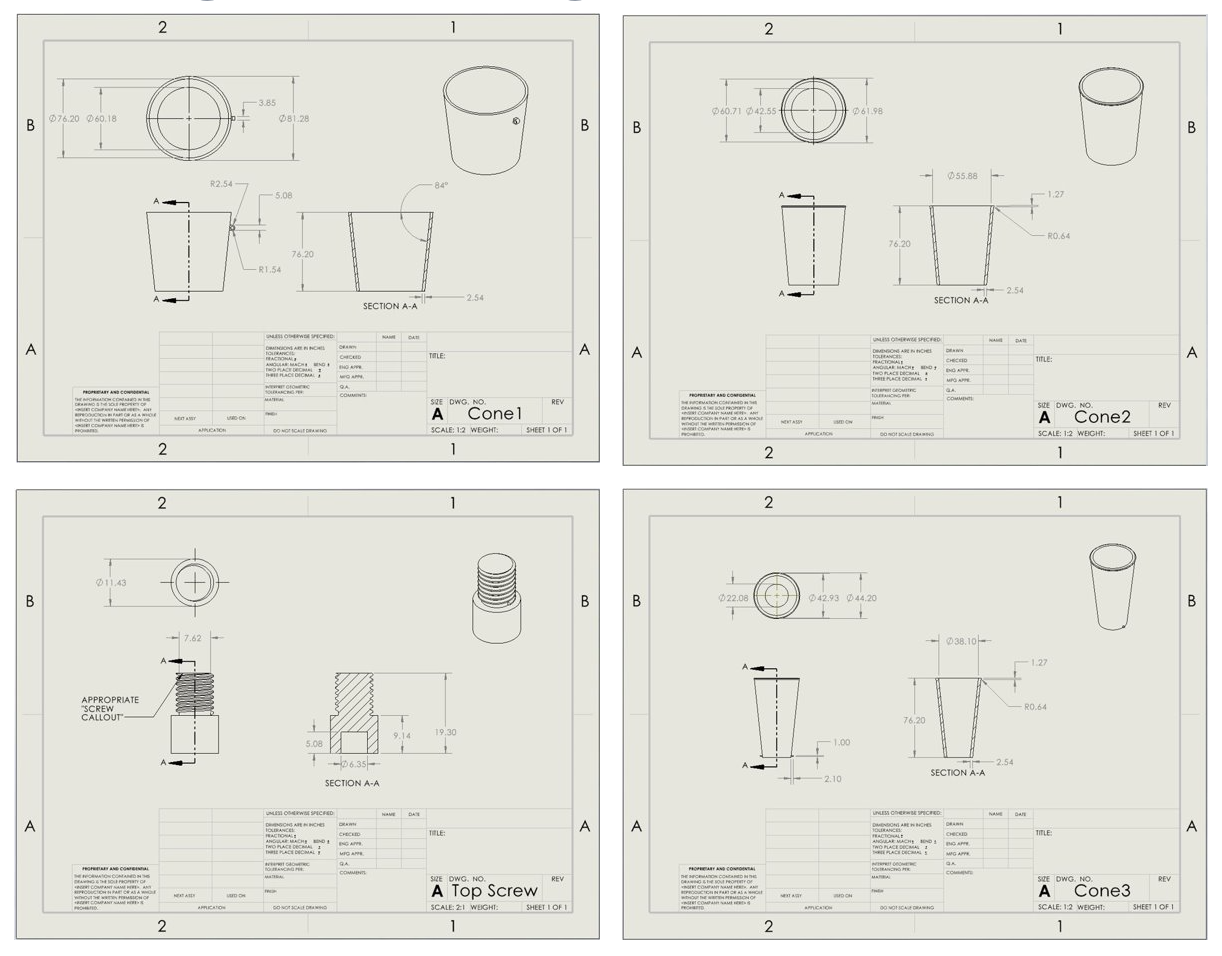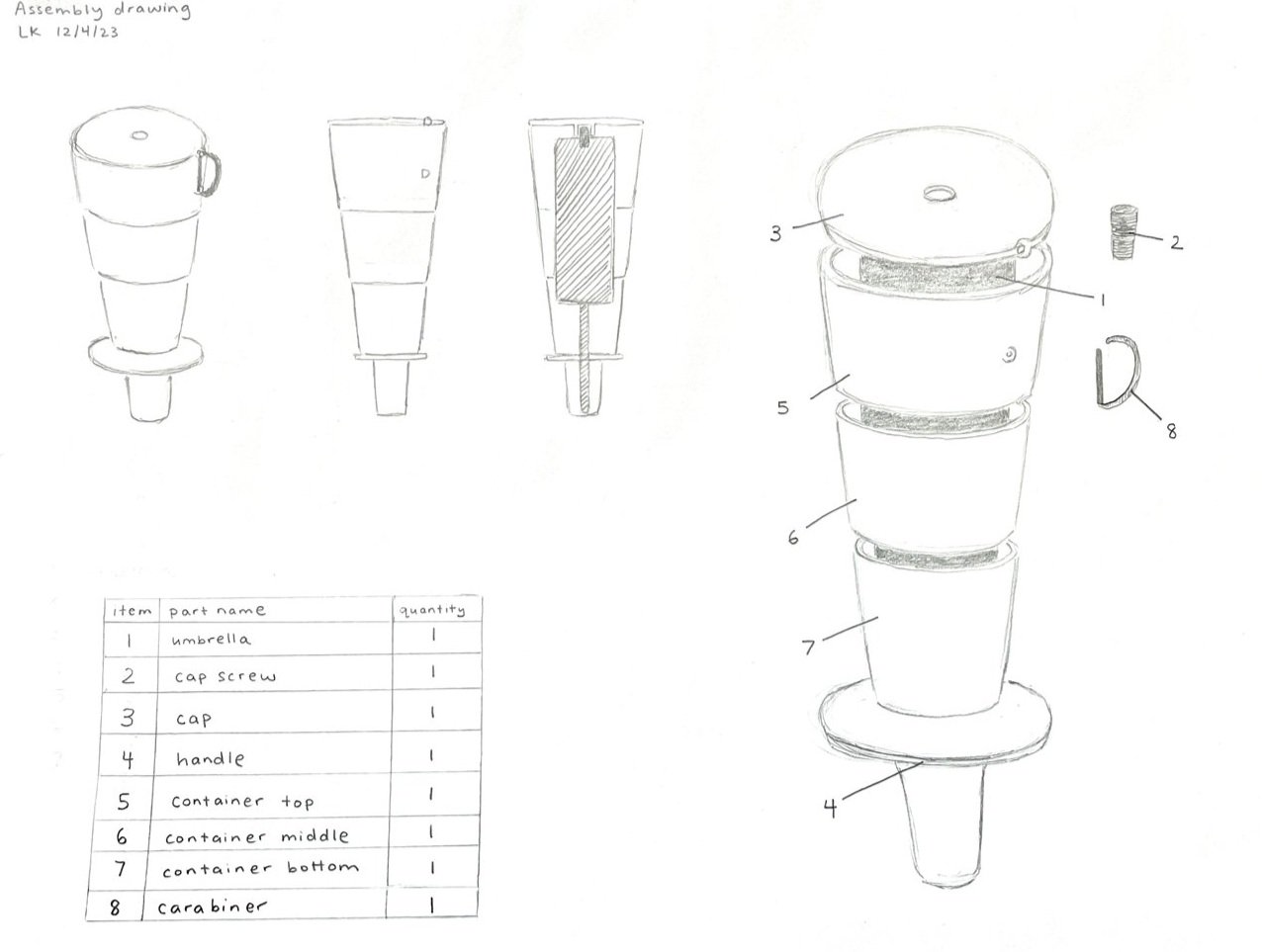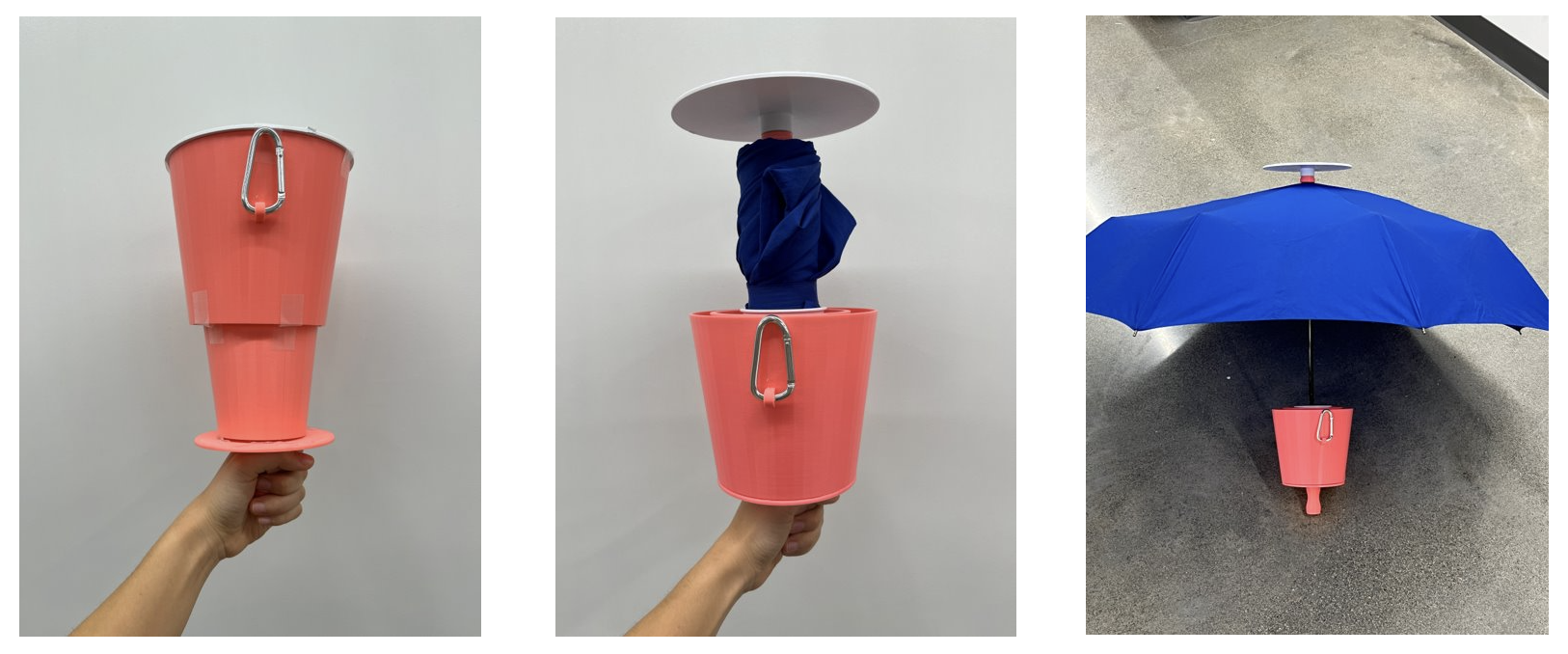
UmbrellaScope
September - December 2023
Role: Product Designer
Type: Product Prototype
The UmbrellaScope is a umbrella with a built-in storage container that provides a quick, compact, and mess-free fix that keeps you dry outside in the rain and your belongings dry when it’s time to go inside.
For this project, I started by brainstorming a bunch of different problem areas. It was raining that Tuesday we had class, so I thought of issues pertaining my commute to campus that day. I looked around the classroom and saw umbrellas strewn about, leaving dark spots of puddles on the carpeted floor and backpacks wet. I realized how inconvenient an umbrella is once you’re inside—where do you put it so that your things don’t get wet, especially in a classroom?
So, the problem statement my teammate and I came up with was: A wet umbrella is inconvenient for people moving outdoors to indoors, and drying the umbrella in an efficient manner is difficult.
When people use umbrellas in the rain, they want to avoid getting their destination's surroundings wet and put their umbrella someplace where they are not inconvenienced with the water. But, they cannot do that well because…
Their umbrella dries most quickly when fully opened which takes up too much horizontal space and results in water on the floor
There aren't many storage (for drying) options in public shared spaces so the floor and/or a user's belongings will inevitably get wet
Brainstorming Design Concepts
After brainstorming individually, we condensed our similar ideas and came down to 18 unique ideas. We generated critical criteria for comparing the concepts, and then sorted them into 4 categories.
Full umbrella design
C1 – New Material Wrung Out Umbrella
C2 – Removable Panels Umbrella
C3 – Replaceable Canopy Umbrella
External drying/storing unit
C8 – Hanging Wall Storage
C9 – External Entry/Exit Container
C10 – "Water Bottle" Container
C11 – Quick Friction Container
C12 – Desiccant Box
Concept Numbers and Ideas
Umbrella attachment/modification
C4 – Fan Attachment
C5 – Panel "Gutters"
C6 – Round Drying Ring
C7 – Drying Brush
Technical (requiring machinery)
C13 – Shaker Machine
C14 - "Dyson Dryer" Device
C15 – Centrifugal Spinning Device
C16 – Powered Air Tube
C17 – Horizontal "Rotisserie" Device
C18 – Vertical "Shawarma" Device
Next, we created a Pugh matrix to downselect to 6 concepts. We compared the ideas to a middle of the road (MotR) idea: C1 – New Material Wrung Out Umbrella because C1 is a standard umbrella with a new material. This resulted in 3 clear winners (C6, C7, C10) and 5 move on ideas (C2, C4, C19, C21, C22). After removing an idea and combining redundant ideas, we had 6 concepts: C2 – Removable Panels, C4 – Fan on Umbrella, C6 – Drying Ring, C7 – Drying Brush, C19 – Solar Oven, and C23 - "BottleScope".
Concept Downselections
Next, to downselect to 3 concepts, we weighed each of our 6 critical criteria:
Min. cost for buyer (Weight: 5) - design requirements outline for product to be affordable for avg. user
Ergonomic (Weight: 3) - not all concepts designed to be "fit" to person (e.g. comfortability not req.)
Portability (Weight: 2) - not all concepts designed to be portable
Safety (Weight: 1) - all concepts safe
Min. power usage (Weight: 2) - all concepts relatively low power
Min. size (Weight: 6) - taking up space is critical, as outlined in problem statement
Min. drying time (Weight: 7) - a low drying time deemed most critical, as outlined in problem statement
Six concepts:
C2 – Removable Panels
C4 – Fan on Umbrella
C6 – Drying Ring
C7 – Drying Brush
C19 – Solar Oven
C23 - BottleScope
C6: Drying Ring — Flexible ring slides down umbrella and squeegees water off
C7: Drying Brush — Flexible brush to manually wipe off umbrella.
C23: BottleScope — Umbrella with telescoping storage
Preference Test
To help us gain more insight on our concepts before downselecting to 1, we conducted a preference test with a set of 6 interview questions.
Key Findings
The bottle is convenient and portable because it's already attached to the umbrella, so users don’t need more space or carry an additional item
The bottle described as a "quick fix" by one interviewee, as in a fast way to stash the umbrella and its potential mess away, which was important for users since time was a big factor in their likelihood of using the product
Described ring as portable and compact, some thought the concept was better suited as a sponge rather than made of a harder material. Potentially messy since can get water on user when using
The ring is more intuitive and convenient than the brush. There is higher likelihood for ring to be used if attached to the umbrella and not stand-alone item
User must remember and have time to use ring or brush before going indoors which requires effort and isn't always likely for users
Most people found the ring and brush to have distinct purposes/uses, but a few thought they were similar in ways other than form factor
Users were also asked to rank the likelihood of using our products from 1 - 5 (1 being unlikely to use the product or too much effort needed to use, and 5 being most likely to use product)
Average ranking 1-5 for brush: 1
Average ranking 1-5 for ring: 3
Average ranking 1-5 for bottle: 4.5
Thus, from the preference test, the bottle was the top choice.
Downselection to 1
Three concepts:
C6 – Drying Ring
C7 – Drying Brush
C23 - BottleScope
From this Pugh matrix, the ring and bottle concepts tied score, so based on the preference test responses, we selected the bottle as our final concept.
For our low fidelity prototype, we used an umbrella, cardboard, tape, and latex gloves to replicate a “stretching-over” movement and containing of the umbrella (V1). We ideated a model using a collapsible silicone water bottle and potentially using a flexible material that can stand up on its own like silicone or rubber. We experimented with cup telescoping using paper cups and then a collapsible silicone water bottle for a “foldable” container. We also experimented with a silicone swim cap for a “squished” container, modeled after the latex gloves we had originally tested out at the start. For the cap and base (handle) of the umbrella storage container, we thought about potential materials and fastening methods.
Our prototype model V2 replicated the movements associated with the BottleScope, and was made out of an umbrella, aluminum expandable cylinder, cardboard, and tape. It helped us get to important design questions involving mounting and telescoping orientation.
Prototypes
The preference tests responses were used to reweigh critical criteria and scores. Expectedly, portability was important, but drying time was not as much of a focus. We also defined portability as how many items and how easy it is to carry items. Minimum power was defined by the minimum mechanical effort required to use.
Sketches and Engineering Drawings
Assembly Drawing
Isometric and orthographic views of the V3 model show the 8 parts:
Umbrella
Cap screw
Cap
Handle
Container top
Container middle
Container bottom
Carabiner
Bill of Materials and Pricing
Since we plan on using a manufactured umbrella from a supplier (~$3-6), most of our costs will come from that. We would use injection molding for the container cones, cap, and handle. Our estimated costed bill of materials then comes to $11.53, making our estimated retail price around $46, which is more expensive than we had expected.
Final Product and Next Steps
After 13 weeks, my teammate and I had a workable 3D printed prototype of our UmbrellaScope. It was much bigger than expected, as we had to account for error and workability for our 3D print. After presenting our findings to the class, we reflected on our process and experience
If we had a few more weeks, we would...
Work on the size: scale dimensions down, make more streamline and seamless to umbrella shape/size because it is not as small and compact as we intended
Implement drainage system in cap (twist-hole cap, like seasoning shakers)
Work together in person more to stay consistent with design and ideas (ex. we both had slightly differing visual ideas of model V3 when we compared individual sketches)
Conduct usability testing with V3
Work out costs more, try to bring total RTP down




